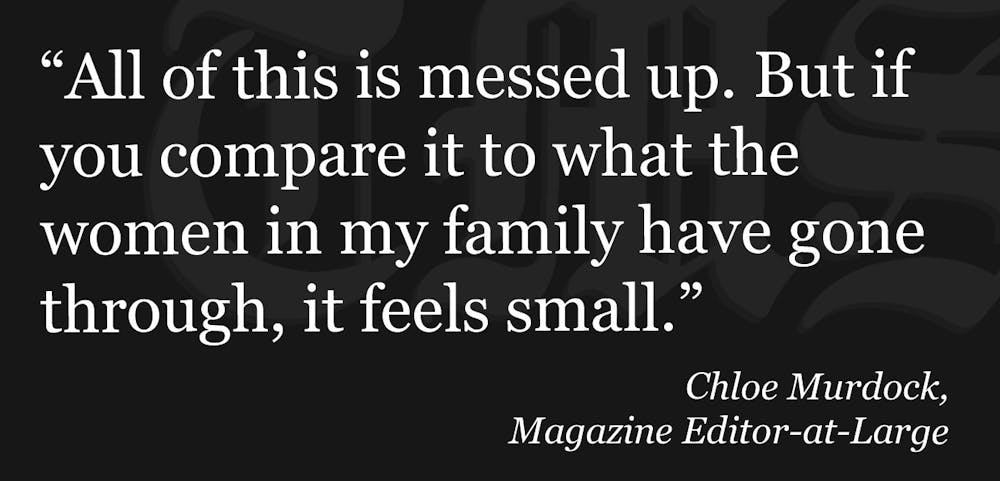I am the same age that my mother was when she had me — 22. I was born on the same day she had to take a college statistics exam. Her professor gave her an A since she’d been going to all the study sessions.
I am also the same age that my grandma was when she had her second child, my mom.
It’s the end of Women’s History Month, and I’ve been thinking about what we’ve all gone through.
I had athletic shorts as a little kid that said “Sweet Stuff” on the waistband. Whatever “Sweet Stuff” meant — I think it was a LimitedToo clothing line — I was obsessed with the cursive lettering.
I was on the sidelines during my little brother’s peewee baseball game, and I showed the waistband to a dad who had been joking around with my parents.
He got serious.
“Don’t show anybody your sweet stuff.”
I didn’t know what that meant, but I felt ashamed.
I was about six years old.
I was a middle school cheerleader. After games ended, the cheerleaders joined football players to high-five the other team and say “good game.” That night, I was the very last person in line. I remember our team had won.
A player in the middle of the line swiveled his hand 180 degrees after high-fiving mine and hit me on the back of my skirt. I looked back but couldn’t identify him. They all looked the same in helmets.
I told my friend’s mom who was driving me home. I brought it up with a question at the end of my voice as if to ask, “Is this wrong, what happened to me?”
Enjoy what you're reading?
Signup for our newsletter
She changed the subject. I was in seventh grade.
I forgot about it until I read Miami’s definition of sexual harassment.
In high school, I wore an ill-fitting cheer skirt that the coaches would always approve at the beginning of every season. It wasn’t ill-fitting because it was too short for me, but because it was too long. When I wore my uniform, boys would occasionally brush their hand across my butt or bump into me if they passed too close. I was a fast walker, I was on my way to class, I didn’t think anything of it.
I was 21 when I found out about drive-bys. This is when someone pretends to brush their hand across another person “accidentally” while passing by to touch them inappropriately and get away with it.
A guy once put his hand gently on my throat without warning me. I don’t know why I wasn’t more alarmed, but I simply asked him what he was doing.
“You’re like a small cat. You would be so easy to break.”
What?
All of this is messed up. But if you compare it to what the women in my family have gone through, it feels small.
As a kid, I thought it was normal to divorce and get back together. I was waiting for my parents to do the same.
My grandpa used to drink. And smoke. A lot.
When my mom was in high school, she and my grandma couch surfed after my grandparents separated. They divorced, though they later started living together.
My grandpa stopped drinking and smoking after he had emergency open-heart surgery. He wanted to be alive to watch his grandbabies grow up.
In 2018, my grandparents remarried. I was there. It was a good day. Everyone cried.
When my great grandma Hilda was in school, a white teacher would tell her she was stupid and that she would marry a “Mexican bum.”
“I married a white bum instead,” she told me.
Hilda moved away from family to live with her husband and her in-laws in Maine. Her in-laws would point at Native Americans who lived nearby and tell her horrible things: They were ugly, dangerous, not to be trusted. Stay away.
“I looked like them,” Hilda said.
Her husband and in-laws scared her more.
My great grandpa Bud drank a lot, and he abused Hilda throughout her life. After six kids, they divorced after he cheated on her.
She splurged on a big opal ring that she called her divorce ring. She wore it on her ring finger even after her father, on his deathbed, convinced her to remarry Bud.
On that same deathbed, Hilda said her father apologized for treating her poorly, thanked her for taking care of him as he had gotten older, and cursed her sister Olga, my great aunt. Olga had been his favorite, but Hilda said Olga was cruel to their parents in their old age.
Olga had terrorized Hilda their entire lives. According to Hilda, Olga would lie to their father about Hilda talking to boys at school. So their father would beat Hilda.
Then Hilda, whispering this part spitefully, said Olga had lived with another woman.
“She was a lesbian.”
Hilda told me Olga’s secret long after Olga had died. Hilda meant this as a slight to Olga, who never married. Despite her creepy doll collection and her intensely mean gossip, Olga was one of my favorite relatives when I was little. She was like the family Disney villain.
If I had known someone else in my family was queer as a kid, maybe I would have felt less alone.
I am not Mormon. But both sides of my family are if you look a few generations back. One benefit of being descended from Mormons is that my genealogy is extremely detailed.
Great-Great Grandma Armandina had a horde of kids, including Hilda and Olga. She also had a miscarriage she had already named — Jorge.
In the Mormon faith, you can’t sully your body with drugs like cigarettes, alcohol or even coffee. But Armandina secretly smoked on the porch when cigarettes were considered “torches of freedom.”
When someone came around the corner, like my Papaw who also smoked at the time, she would put out the cigarette on her tongue and flick it away. I wonder if she could even taste food.
Before she married, Armandina was a flapper. She rode motorcycles borrowed from friends.
Her husband, Eduardo, beat her while he was drunk. As a kid, my grandma would be rushed out of their house when it started.
Armandina never met her mother-in-law, Serapia Alfaro. Serapia was Tlaxcalteca. Her husband Ramon and his Catholic family were from Spain.
According to family records, Serapia was uneducated and brown. Also according to family records, Ramon’s family hated her.
Ramon died in a railroad accident in 1901, the same year his son Eduardo was born. Serapia was 15.
When Eduardo was only seven, Serapia died of tuberculosis.
She was born in 1886. She died in 1908.
She was 22.




